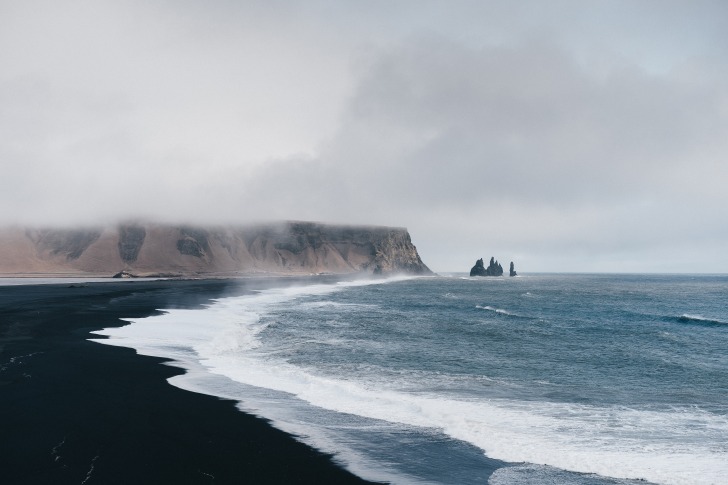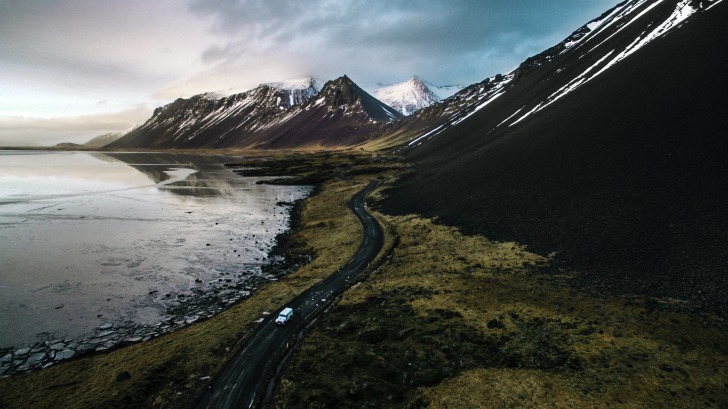Sharks are located in any true sea or ocean worldwide, even around the Arctic Circle.
You can find sharks of every shape and size in different areas.
As a human, you can quickly become lunch for a hungry or threatened shark if you aren’t careful when swimming in shark-infested waters.
If you’ve ever visited Iceland, the only shark you may think of is the fermented version consumed as a dare by your buddies.
However, you have yet to think about sharks in the waters surrounding the island likely, so where do Icelanders get this meat?
Keep reading to learn more!
Contents
So… Are There Sharks in Iceland?
Sharks are most attracted to habitats with warm waters and plenty of food.
Therefore, the further north you go, the fewer shark species you will find.
For example, since Iceland sits above the Arctic Circle, only one species lives there.

The only species in Icelandic waters is the Greenland shark.
This is the coldest tolerant shark species on earth and familiar to the northern Iceland waters.
The Greenland shark has been caught in local waters since ancient times since Iceland has no natural land-based food due to its rugged and barren landscape.
During the 19th and early 20th centuries, the Greenland shark was considered one of the most important commercial species in the country.
Until the 20th century, shark fisheries were critical to the country’s northern section due to the large sailing boats operating through Eyjafjorour.
Is it Safe to Swim in Iceland?
While Iceland is famous for its hot springs and thermal pools, many locals also like to dip in the 39F ocean citing many health benefits.
Swimmers in Iceland are not going for a quick dip like in Finland after the sauna.
Instead, Icelanders throw on the swimsuit and go for actual five-minute swims in the ocean.
If you’re planning to take a dip in the Arctic Ocean, it can be perfectly safe, but essential to be aware of the following:
Changing Weather
In the winter, the weather in Iceland changes at the drop of a hat.
One minute it’s sunny, and the next, it’s a blizzard.
Swimming without the proper protective gear in a blizzard can create low visibility, which could impact returning to shore.
Therefore, it’s crucial to stay within the shoreline if a massive squall appears, leaving you stuck in the almost freezing water.
Hypothermia Concerns
Before entering the water, it’s critical to familiarize yourself with hypothermia symptoms and signs since it creeps in slowly.
Hypothermia occurs when your body temperature falls below 90F, resulting in persistent shaking, coldness, and low energy.
If you’re swimming when this happens, you can quickly pass out and drown.
Therefore, the second you experience heat loss, it’s time to go back to shore and slowly warm up so the symptoms don’t persist.
In addition, before hypothermia is present, you will likely lose feeling in your hands and feet, which can cause further problems returning to shore.
Rip Currents
Every ocean has rip currents that pull the water back out to sea in an endless tug-of-war between water and land.
When rip currents occur in specific spots on the ocean floors, channels start to form due to erosion.
Getting caught in a rip current can sweep you out to sea in the blink of an eye.
Never Swim Alone
There are enough hazardous situations that can occur when swimming in the ocean in warm climates; add hypothermia, sharp rocks and obstacles, and frigid waters to the list when swimming in Iceland.
That means you must have a partner when swimming in case something goes wrong.
They don’t necessarily need to be in the water with you but should be on the shoreline checking up.
Wear Special Shoes
The Land of Fire and Ice is chock full of rocks along its stark landscape.
Plenty of sharp volcanic rocks on the ocean floor, so wearing water shoes when taking a dip is necessary.
Besides a good pair of shoes, you don’t need any special equipment.
If you’re planning to be in the water for lengthy periods, you must have a dry suit, so you don’t freeze to death.
Work Up a Tolerance
The first few seconds of entering the water are always the most difficult.
Experts recommend that the first few times swimming in such frigid waters should only last 30 to 60 seconds.
After that, more seasoned Arctic swimmers should only remain in the water for three to five minutes to avoid hypothermia.
After that time, you can feel your muscles contracting.
Interesting Shark Facts in Iceland
Given that it’s the only species as far north as Iceland, the Greenland shark has many interesting facts and features, including:
- It can live in waters 7,200 feet deep that are as cold as 28.4F.
- It’s one of the slowest shark species on earth.
- Its scientific name is Somniosus microcephalus, which translates to a sleepy small head.
- It’s the largest fish in the ocean
- It’s the world’s longest-living vertebrate.
- This shark can live for 400 years, double the age of the longest-living land animal.
- The shark’s tissues contact chemical compounds similar to anti-freeze that prevents ice crystals from forming.
- This species has been spotted as far away as the western Caribbean and the high Russian Arctic.
- This species is considered a top ocean predator.
Six sharks can be found in freshwater rivers worldwide, but only the Bull shark can seamlessly move between freshwater and saltwater without any issues.
This is because the Bull shark has the organs to process salt and freshwater while maintaining a balance of both internally.
Freshwater sharks can’t process the excess salt in the water, and saltwater sharks lose too much salt when swimming in freshwater, so it’s rare to find sharks in both.
Also, for saltwater sharks to end up in freshwater lakes or rivers, there must be a connection with brackish water between the ocean and freshwater, hence why you can sometimes find the Bull shark 60 miles up the Mississippi River.
Additionally, the freshwater body must be incredibly deep for the shark to navigate.
However, they retreat to saltwater locations once they detect the lack of salinity, which causes dehydration, weakness, and dulled senses.

3 Safety Tips for Swimming in Shark-Infested Waters
While it’s never advisable to swim in shark-infested waters without an experienced guide or the proper protection and equipment if you must, there are several safety tips to follow:
Don’t be a Fool
While this safety tip shouldn’t even be mentioned, just in case you see a shark, get out of the water.
Don’t try to get a selfie with the shark in the background, even if it only takes a moment.
Don’t go full Jaque Cousteau; grab it by the fin or even touch it.
The only internet glory you will likely receive is going viral for becoming bloody foam.
Maintain Eye Contact
If you come across a shark, start calmly heading towards land.
While moving toward the shoreline, maintain eye contact with the shark, especially if they attempt to circle.
This is called staring them down, which many shark divers claim helps deter aggression because you are aware of their presence.
Use Shark Repellent
There’s a variety of shark repellent products on the market, some of which utilize a substance in putrefied shark tissue, some are chemicals, and some use magnetism.
There are wearable electromagnetic devices that generate a field and repel the shark.
Additionally, you can purchase a special wet suit that makes you more invisible to sharks.
The only surefire repellent is to get out of the water if you see a shark.
Summary
Surprisingly, Iceland and the Arctic region have a single species, the Greenland shark, which has been instrumental to the local economy and a food source for hundreds of years, dating back to the Vikings.
This shark is the largest fish on the planet.
While incredibly slow-moving, it catches plenty of prey, including eating land animal carcasses that have fallen into the ocean.
If you plan to go swimming in Iceland during your next visit, there are plenty of other hazards beyond being attacked by a shark.
The most severe and realistic threat is hypothermia from swimming in almost freezing waters for longer than five minutes maximum.
Those not used to these frigid temperatures must work up to build a tolerance against the cold, starting with a 30-to-60-second swim.
If you find yourself swimming in shark-infested waters, remain calm and don’t act like a fool; exit the water, maintain eye contact with the shark while escaping, and try to use some form of shark repellent to keep them away!
Iceland Safety Overview
READ THE FULL REPORT: Iceland Safety Review
Safety Index:
- OVERALL RISK: LOW
- TRANSPORT & TAXIS RISK: LOW
- PICKPOCKETS RISK: LOW
- NATURAL DISASTERS RISK: MEDIUM
- MUGGING RISK: LOW
- TERRORISM RISK: LOW
- SCAMS RISK: LOW
- WOMEN TRAVELERS RISK: LOW
Frequently Asked Questions
What family is the Greenland Shark part of?
The Greenland shark is part of a family called sleeper sharks.
This is because they are incredibly slow swimmers and generally lazy.
This shark type can grow up to 21 feet long and weigh more than 2,200 pounds!
What does a Greenland shark look like?
The Greenland shark is black, brown, or dark gray with no anal fin, a rounded snout, small eyes, and a cylinder-shaped body, like a submarine.
The Greenland shark can grow up to 23 feet and weigh 1.5 tons, whereas the great white shark grows up to 20 feet and weighs 2.5 tons.
This species has pointed upper teeth and broader, squared teeth on the lower jaw, so when holding prey, they roll their head in a circular motion to tear flesh chunks away.
Can you eat a Greenland Shark?
This shark processes liquid waste through its meat, making it unfit for consumption without special treatment.
The Greenland Shark is used in a popular dish called hakarl, where the meat is fermented for months and then hung to drain the pungent ammonia before consumption.
It’s typically served in small, uncooked cubes and has been consumed for generations.
What does the Greenland Shark eat?
As is synonymous with being a sleeper shark, the Greenland Shark eats just about anything it can find and is famous for being a glutton.
Various marine and land animals have been found in its stomach, including reindeer, horses, dogs, polar bears, and cats, all likely carcasses that drifted out to sea.
Experts now believe they are opportunistic hunters that ambush seals using a stealth attack method.












Iceland is home to the Greenland shark, the only species found in its waters, but swimming safely in Iceland requires precautions against changing weather, hypothermia concerns, rip currents, and never swimming alone.